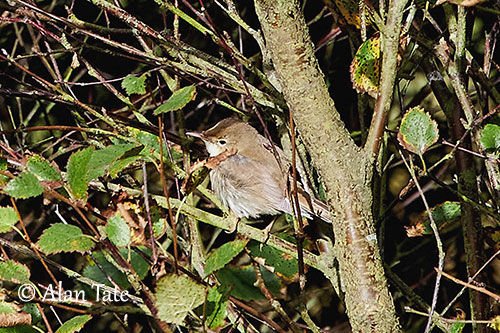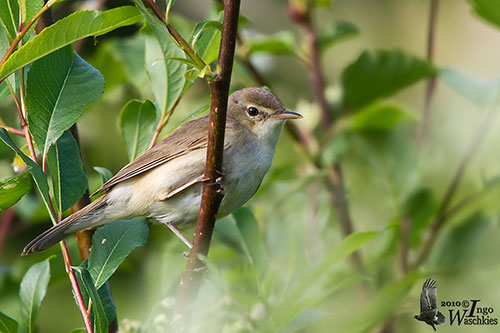
Fr: Rousserolle des buissons
Ang: Blyth's Reed-Warbler
All: Buschrohrsänger
Esp: Carricero de Blyth
Ita: Cannaiola di Blyth
Nd: Struikrietzanger
Sd: busksångare
Photographers:
Jean Michel Fenerole
Photos d’Oiseaux du monde
William Price
PBase-tereksandpiper & Flickr William Price
Alan & Ann Tate
AA Bird Photography
Ingo Waschkies
Bird Photography
Text by Nicole Bouglouan
Sources:
HANDBOOK OF THE BIRDS OF THE WORLD Vol 11 by Josep del Hoyo, Andrew Elliott and David Christie - Lynx Edicions - ISBN: 849655306X
Reed and Bush Warblers Par Peter Kennerley, David Pearson – Helm Identification Guide – Editeur: A&C Black, 2010 – ISBN: 1408134012, 9781408134016
Warblers of Europe, Asia and North Africa De Kevin Baker – Editeur: A&C Black, 2010 – ISBN: 1408131706, 9781408131701 - 360 pages
Field identification of Blyth's Reed Warbler
Polygyny in Blyth's Reed Warbler Acrocephalus dumetorum
Blyth’s Reed Warbler (Acrocephalus dumetorum)
Wikipedia, the free encyclopaedia
Blyth’s Reed Warbler
Acrocephalus dumetorum
Passeriformes Order – Acrocephalidae Family
INTRODUCTION:
The Blyth's Reed-Warbler is an Old World warbler found in the Palearctic and easternmost Europe where it breeds. It winters in S and E Indian Subcontinent and Myanmar.
It frequents varied habitats, not necessary near water. It breeds in shrubby growth with tall herbage, overgrown clearings, scrub in floodland groves, bushy farmland, swamps and other waterside edges. During winter, it is found in similar habitats but often away from water.
The Blyth's Reed-Warbler is an insect-eater, but it occasionally feeds on seeds and berries, depending on the season. It usually forages in foliage of trees and bushes, but also in open ground.
During the breeding season, the male is monogamous, but sometimes polygynous. The nest is a compact cup built mainly by the female in thick herbaceous layer, sometimes in shrub or low tree.
The Blyth's Reed-Warbler was first described in 1849 by Edward Blyth, an English zoologist working in India at this period.
The species is not globally threatened and the population is suspected to be increasing.

DESCRIPTION OF THE BIRD:
Biometrics:
Length: 12-14 cm
Weight: 11-12 g
The Blyth's Reed-Warbler has drab, unstreaked plumage. Crown and upperparts are olive-brown and the upperwing is rather uniform (the dark brown alula is absent), and the paler feather fringes are indistinct. The tail is like the upperparts. Both wings and tail are rounded.
The paler underparts are whitish, but breast sides and flanks show grey-buff wash. Chin and throat are whiter.
On the head, the crown is olive-brown. We can see a whitish supercilium, more conspicuous in front of eye. A dusky eyestripe is often well visible. A white eyering is mostly apparent below the eye.
The fairly long bill is dark grey horn but the lower mandible has pale pinkish base. The eyes are dark brown. Legs and feet are dull grey, sometimes pinkish-brown, especially in juveniles and 1st winter.
Male and female are similar.
The juvenile resembles adults but the plumage appears warmer brown above and often yellower below.
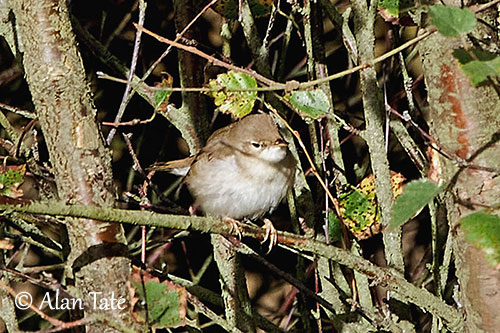
RANGE:
The Blyth's Reed-Warbler breeds in the cooler temperate regions of W and C Palearctic. The breeding range has expanded throughout the 20th century and reached S Finland before 1950s.
The breeding grounds are found in E Europe (S Finland, Baltic states and Belarus), E to N Kazakhstan, NW Mongolia and C Russia, also Tien Shan and S to probably N Afghanistan and NE Iran.
The species migrates after the breeding season, to spend the winter in S and E Indian Subcontinent and Myanmar.
HABITAT:
The Blyth's Reed-Warbler breeds in dry to slightly damp open and bushy areas with dense undergrowth including emergent nettles, and scattered trees or large bushes often used as song-posts. It may also breed in tall forest with dense understorey, bushy field edges and abandoned farmland. Most of the territories include open areas.
During winter, the Blyth's Reed-Warbler frequents dry scrub including in urban parks and gardens, and open forest throughout the lowlands in the Indian Subcontinent.
While migrating, this species can be seen in various habitat types, often from low scrub to woodland habitats.
It is visible from lowlands and hills to 1,200 metres of elevation, and up to 2,100 metres during winter.
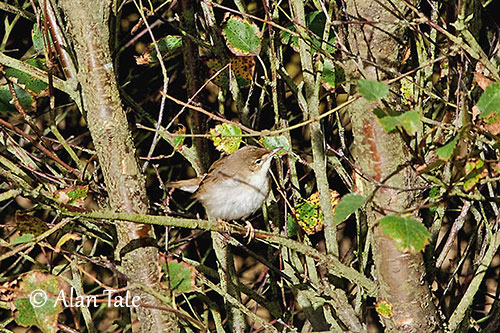
CALLS AND SONGS: SOUNDS BY XENO-CANTO
The Blyth's Reed-Warbler frequently gives a short, hard “tuk” slightly softer than that of the Lesser Whitethroat or the Dusky Warbler. We can also hear a harsh “schaarr” call frequently given during winter. The alarm call is a dry, rolling “krrrreet”.
The song has rich and fluty quality and contains masterful mimicry. It is a very good identification feature in the wild.
The song is mainly given between dusk and dawn. It includes a large variety of harsh and clear notes, and mimicry too, repeated slowly 3-5 times, sometimes up to 10 times. The bird may also produce a clicking call between repetitions.
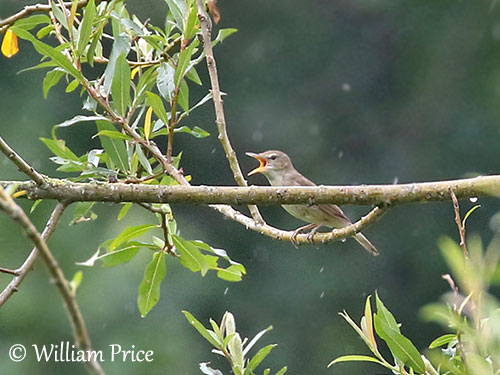
BEHAVIOUR IN THE WILD:
The Blyth's Reed-Warbler feeds primarily on insects of numerous species including adults and larvae. It also consumes spiders and snails. Depending on the season, seeds and berries are also part of its diet.
The bird forages actively in the top and side of foliage of trees and bushes, but it also comes down to the ground in low undergrowth or open ground. It forages by hopping on the ground, but it also catches insects in flight by sallying out from a bush. Then, it returns to the same bush.
The bird is often seen raising, flicking and fanning the tail in nervous manner.
At the beginning of the breeding season, the male sings from a prominent perch, a bush or a high branch of tree, up to 20 metres or more above the ground. While singing, the male often drops the wings along the flanks and dips the tail in rhythm to the repetition of the song sequences.
The unmated males sing strongly during the twilight hours and at night, and continue after dawn.
The males arrive on the breeding grounds 8 days before females. The song becomes less frequent in mated birds. The species is usually monogamous, and occasionally polygynous. The males may mate with several females in adjacent territories.
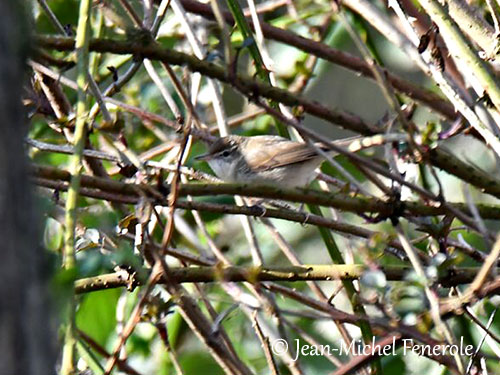
The Blyth's Reed-Warbler is migratory. The birds leave the breeding grounds in July and August. They are present on their wintering grounds from September, but only from Late October in Sri Lanka.
The return migration occurs from March to May. Some vagrants are recorded W to Britain.
The Blyth's Reed-Warbler has short, rounded wings, and when performing fluttering flight over the low cover, the wings but also the fairly long and broad tail recall the Cetti’s Warbler.
REPRODUCTION OF THIS SPECIES:
The breeding season takes place from late May to July. The Blyth's Reed-Warbler produces a single brood per season.
The species is monogamous, but also occasionally polygynous. They are solitary and territorial, but at sites with high density of males, two or more pairs may nest in close proximity.
Both mates build the nest, but sometimes the female alone makes the nest. This work may last 3-4 days.
The nest is a compact cup of dry grass stalks and leaves, rootlets, plant fibres and spider web. The cup is lined with softer material such as finer stems and hair. It is built in dense vegetation, about 20-60 centimetres above the ground, rarely above water. The size of the territory (in S Finland) is about 600-1,300 m².
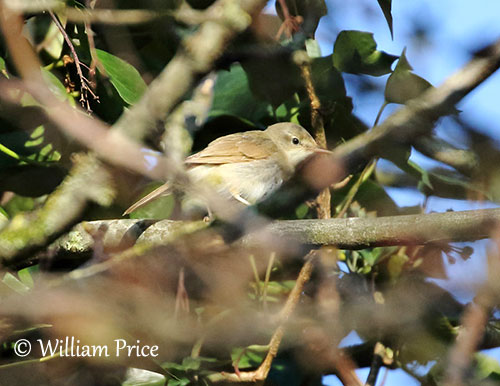
The female lays 3-6 eggs and both mates (mainly the female) incubate during 12-13 days. The young are fed by both adults and fledge 11-13 days after hatching. They still depend on parents for 10-22 days.
The male sometimes disappears during the fledgling period, probably searching for another female. The first female cares for the brood alone.
PROTECTION / THREATS / STATUS:
The Blyth's Reed-Warbler has adapted to varied habitats and has a large range in which it is not globally threatened.
A very preliminary estimate of the global population size is 21,800,000/47,800,000 mature individuals. But more information is needed.
The population is expanding the range in the West, and the numbers are suspected to be increasing.
The Blyth's Reed-Warbler is currently evaluated as Least Concern.
